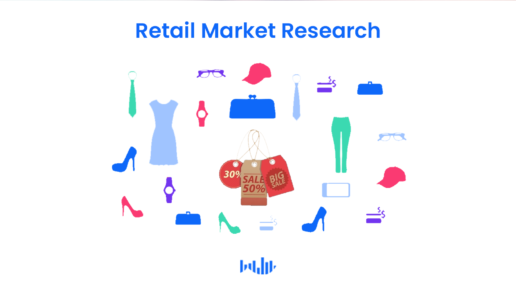How to Get Insight from Consumer Panel Surveys: 10 Tips
How to Get Insight from Consumer Panel Surveys: 10 Tips

Alongside focus groups and ad-hoc questionnaires, consumer panel surveys are a popular tool for businesses looking to gain insight into what their audiences – and consumers at large – are thinking.
Using pre-recruited and pre-screened groups (or panels) of respondents, consumer panel surveys have specific advantages over alternative consumer research methods. You can control your audience, for example, and return to the panel over time to collect data repeatedly from the same set of people. This lets you dig deep into highly targeted audiences – and, crucially, compare changes in attitude over time.
Yet, as with all research methods, to get real value from consumer panel surveys, you need to refine your technique. That’s why, in this article, we’re sharing 10 tips and best practices to get the most from your consumer panel surveys. We’re talking how to shrewdly recruit and screen respondents, how to ask questions that elicit authentic opinion, and how to use the right analytical methods to yield deep insight.
Note: Don’t forget, Pollfish has created a new consumer research methodology that works a little differently. One that fulfills the promise of consumer panel surveys, while keeping bad data to a minimum – and making access to deep insights easier and more efficient.
Where to Start with Consumer Panel Surveys?
Consumer research can deliver highly valuable insight for your business. Whether you want to test how an ad campaign will land, or get feedback on a new product line, opinion from authentic consumers – and potential customers – can be priceless.
Yet, you can’t just go and fire questions around at random. This won’t tell you anything of value. Rather, thinking through who you are asking and why is crucial before you start.
Here are three tips on how to get that done.
#1: Gain Clarity on Your Research Problem and Goal
We’re starting with the basics, yes. But a true understanding of what you want from your research is an essential element that too often goes overlooked, particularly by businesses conducting research themselves. If you want insights that have value for you, you need absolute clarity on your larger goals.
Do you want to boost sales, refine a specific product, or determine brand positioning? A robust research objective will help you sculpt questions that deliver sharper insights – and save you time asking questions that don’t deliver value.
#2: Refine Your Research’s Scope and Scale
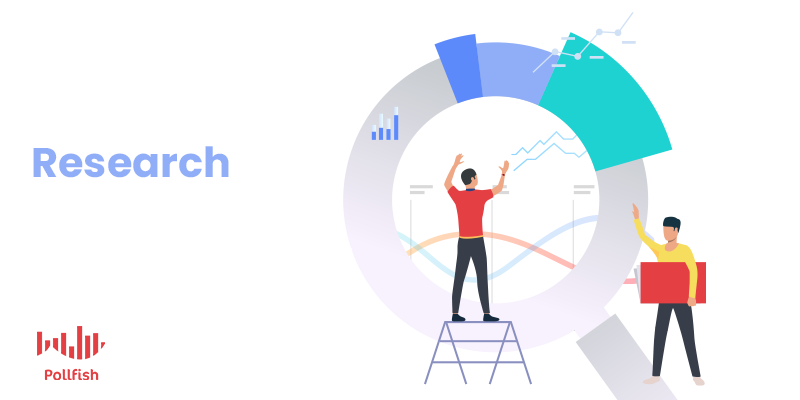
Once armed with a research objective, you now need to assess the desired scale of your research. This can get a little complex – but it ultimately shapes the reliability of your research.
Of course, the ideal survey would consult 100% of your target population – whether that’s marketing graduates in Scotland or cyclists among your company staff. While this scale would yield data on which you can surely rely, this is usually not possible in practice. Even if your target population is very small.
However, the further from 100% of the population, the greater the likelihood of inaccuracy. What you need to decide as a business is what margin of error you can tolerate. If you are making high-stakes decisions, you want data you can trust – and the larger the sample size the better.
#3 Source and Speak to the Right People
For authentic insights that deliver value for you, speak to the right audience. You can’t take this for granted. Before you conduct any survey, you need to recruit respondents that suit your target demographic.
This is what screening questions are for. These filter out respondents who aren’t right for you. However, as our resident expert, Jim Theodoropoulos, notes, using screening questions can be difficult to get right. These need to be combined with demographic targeting to narrow in on your audience.
Using Pollfish, for example, if you are seeking mothers who are runners, you can use the “gender” and “number of children” filters, before asking a screening question about preferred exercise. Like this, you can access deeper insights into specific audiences – and keep the professional panelists to a minimum.
Asking Questions that Deliver Real Value

The way you ask questions – and the form in which you receive answers – affects the quality of your data. And avoiding bias and panel fatigue, for example, can make conducting consumer panel surveys a bit of a minefield.
This is why many businesses use options like Pollfish to help design the questions. But if you’re going it alone, below are some tips on how to ask good survey questions and get answers you can trust.
Note: For more on this, check out our article on how to ask good survey questions.
#4 Ensure Neutrality
Bias is a bad look in consumer research. For surveys to yield data that is actually valuable, they need to tap into the authentic opinion of respondents. Not reflect the prejudices of the researchers.
That means avoiding leading questions, those questions that direct respondents to specific answers. For example, “How would you rate our award-winning customer service?” has the potential to skew responses by including the qualifier “award-winning”.
However, even “what problems do you see in our customer service?” distorts the insights you will receive – as it assumes problems, whereas none may have been seen by the respondent.
This also means providing multiple-choice responses that reflect the range of opinion. If “how would you rate our customer service?” is your neutral question, the possible responses need to achieve similar neutrality. “Extremely helpful / Helpful / Neither helpful or unhelpful / Unhelpful / Extremely unhelpful”, for example, keeps the balance between positive and negative options while keeping framing consistent.
#5 Use Strategies to Mitigate Panel Fatigue
During surveys, and particularly during panel surveys, it’s not unlikely that respondents will become bored or disengaged – even though they sign up to participate.
When respondents are asked too many questions, we call this panel fatigue. It’s one of the biggest downsides to consumer panel surveys. Respondents might lean on “don’t know” or they might start “straightlining” – where they choose the same response for every question.
To avoid this, change up your question formats and shuffle questions around. It boosts engagement. It ensures more trustworthy responses. And it ups your completion rate – making data more reliable overall.
#6 Be Specific – and Remember Your Research Goal
Every question in your survey should provide an insight into your audience’s opinions, attitudes, and behaviors. Those that are irrelevant or too vague are not going to deliver the insights you need to make effective business decisions.
In this way, if you are a gaming app, an open question like “what do you like to do in your downtime?” is not focused enough – and it doesn’t direct respondents’ thoughts to gaming. As such, it won’t provide data that will be of use to your research goal.
Understanding Insights from Consumer Panel Research
You’ve asked the questions. Now, you need to understand the responses.
This will first mean collating recurring answers, identifying patterns, and highlighting anomalies – a process that can be hugely time-consuming if you are doing it alone. That’s why Pollfish, by the way, delivers automated analytics in real-time. More on that later.
Once you’ve arranged the data, you need to analyze it. Here’s how to get started.
#7 Compare Your Data to Larger Trends
Numbers, let’s remember, are all relative. And getting valuable insights from them is difficult when they are viewed in isolation.
Your survey tells you 80% of respondents said that they were happy with your customer service. But for this to be valuable to you, this needs to be put in context. How does this compare, for example, to other businesses of your size in your industry? Or to your results from last year?
Larger trends are your friends – and they help make sense of your customer panel survey. If this is your first survey of its kind, let these results be the benchmark from which you understand future developments. If you have numbers from previous surveys, use these to assess your progress.
#8 Cross-Tabulate – and Dig Deep
Similarly, when you are reading your results, the big picture isn’t always the most useful view.
Say that 65% of respondents in a general population survey said they found your new ad campaign funny or very funny. That might feel like a win. However, these numbers could be disguising insights of more specific value.
That’s what cross-tabulation is about. Using crosstabs can let you see how different data fields overlap – and this is an indispensable tool for analyzing your data. For example, maybe the ad landed much less effectively with women. Or the joke was completely lost on 21-30-year olds.
This matters. There may be an insight you need to address. You just need to dig deeper to find it.
#9 Keep on Researching
In a world in which business competition is sharp, a single survey won’t do. As a result, there’s one tip that needs to be stressed: keep returning to your audience to do more research.
The unique value of consumer panel research is that going back and asking questions is easy. Your panelists are there, pre-recruited, ready, and willing to respond. Make use of them. There is really no such thing as too much data.
#10 Use Pollfish to Make Deeper Insights Easier
At Pollfish, we’ve moved beyond the traditional consumer panel survey. We’ve developed a research methodology that makes gathering insights into consumer opinion easier. It makes recruiting panelists and understanding insights faster, more cost-effective, and less labor-intensive, too.
For example, our consumer research platform sources insights from over half a billion engaged consumers, connected via our network of 120,000 app providers. We screen every participant based on pre-collected demographic, biographic, and behavioral data – as well as your screening questions – to take the stress out of finding the right audience.
Pollfish makes setting research objectives and framing questions easier too. We give you some of the most common research goals and pre-crafted question templates to choose from. To keep bias to a minimum and ensure participant engagement, all you have to do is select.
Finally, analyzing data is easier with Pollfish, too. Our advanced data tools let you filter your findings in real-time. All admin is taken care of, so that you can dedicate yourself to visualizing your insights – and ultimately putting them to work.
Frequently asked questions
What is a consumer panel survey?
A consumer panel survey is a type of survey that is conducted at set intervals over a period of time with the same group of respondents. The time period can range from days to years.
Why are consumer panel surveys used?
With interviews conducted over a period of time, consumer panel surveys are ideal for understanding how the thoughts, feelings, or behaviors of people evolve over time.
What are the benefits of conducting a consumer panel survey?
One of the primary benefits of consumer panel surveys is that they can be used to gain deep insights about a highly targeted audience. In addition, individual surveys are easy to deploy because the respondents have already been identified.
How are screening questions used?
Screening questions are used to identify the appropriate audience or panel for a survey. Combined with demographic targeting, these questions can help identify the best audience for a survey.
What is panel fatigue?
Panel fatigue occurs when survey respondents become bored or disengaged from the survey process, resulting in mediocre or inaccurate data.
What to Look for in Online Survey Tools
What to Look for in Online Survey Tools

Online survey tools are invaluable for market research. In today’s digital world, these are the chief drivers of primary market research, as they allow you to obtain your own results.
Many brands don’t have market researchers on board; thus they don’t have the means to perform self-conducting research. As such, surveys are a vehicle of ease into primary research.
By their very nature, online surveys allow brands to explore the minds of their consumers and prospects.
But choosing the correct online survey tool can be a feat, as there is a slew of survey software available. Navigating the muddy waters of the internet, in which you’ll be constantly inundated with ads, social mentions and other promotional content, can make it difficult to steer you in the right direction.
That’s because all survey platforms will claim to provide the best experience and results for your business. But is any of it true? Don’t learn the hard way; instead, read this article on what to specifically look for in online survey tools for all of your needs.
Macro Applications for Online Survey Tools
Understanding the utility of survey software involves understanding all of the disciplines and campaigns it can be applied to.
Hence, before we delve into the individual capabilities you should seek in a survey platform, you should consider some of their more high-level applications.
Not every survey platform you come across will be able to provide the same value across these areas, so you ought to consider the functionalities of the survey platform you choose. But before that, let’s examine the macro applications your survey tool should aid you in.
- Branding: Branding involves developing a reputation and an image, along with increasing the recognition of your company. A survey should help you in the following for branding:
- Seeing the reception of content, whether it’s visuals or messaging
- Finding the images to use for a campaign (including placement of logos)
- Testing your unique value proposition
- Testing a slogan
- Identifying brand awareness levels
- Marketing: Marketing is an umbrella term that involves all the processes of raising interest in your brand and promoting it, including advertising, distribution methods and sales. A survey should help you in the following for marketing:
- Determining the state of your industry and niche
- Identifying your target market
- Applying market segmentation to your target market
- Seeing if there is a demand for your product or service
- Doing an analysis of your competitors
- Unearthing the attitudes around issues you can later use in your messaging
- Finding the shopping habits of your consumers
- Advertising: Advertising is a form of communication that uses overtly sponsored messages to promote or sell a product or service and is one of the main disciplines within marketing. A survey should help you in the following for advertising:
- Forming the bedrock of an ad campaign based on consumers’ opinions
- Figuring out which topical subjects are too touchy to include in the ads
- Finding ideas for individual ads
- Narrowing the most consumed advertising mediums from your target market
- Testing the efficiency of ads
- Site Traffic/Visitation: Gaining site traffic is a critical campaign in itself. So how would completing a survey — which can be seen as a chore — help on this front?
- When surveys are tailored correctly towards your target market, site visitors will enjoy taking them
- Surveys with images and interactive elements will create engaging experiences
- Users may feel appreciated for taking your survey if you offer thank you emails, incentives, etc.
- Surveys that deal with topical issues may reel in user interest when visiting your site
Features that Make Market Research Easy
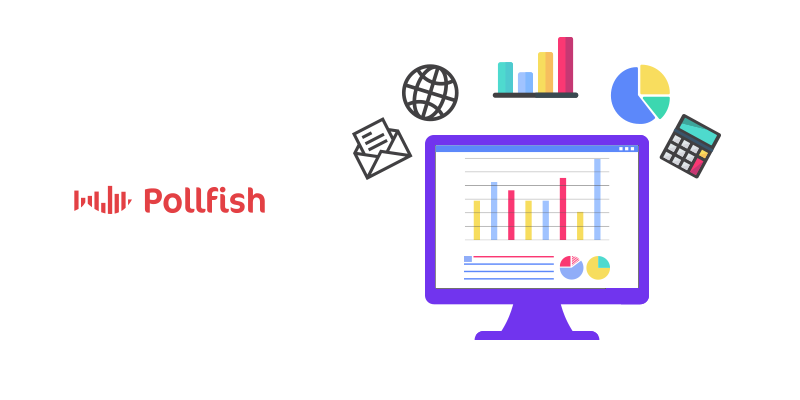 A survey tool needs to be useful for market research. A key part of marketing, this kind of software should have the following:
A survey tool needs to be useful for market research. A key part of marketing, this kind of software should have the following:
- Multiple categories for demographics: this will help you reach your target market more precisely and accurately.
- Adding quotas to any of the demographics to reach your desired amount.
- Multiple sub-categories of demographics to reach your segmented personas.
- Various language options to apply to different countries and speakers.
- The addition of at least 3 screening questions.
What to Look for in the Survey’s Environment

The environment of the survey has to be vast and easily made visible to any demographic of respondents. In addition, it should be able to be widely distributed automatically. Here are the features to look for, for the most fitting survey environment.
- Software with a vast network of publishers: preferably popular websites and mobile apps.
- A wide pool of users associated with the publisher channels.
- An easy to detect element (button) to reach the survey.
- The capability of being supported by over a hundred countries for global reach.
- An easy to integrate API or coding.
Individual Survey Capabilities
These specific features are the micro aspects of the applications to look for in your survey platform. They are immensely important, as they largely involve unique capabilities that distinguish one platform from another. Additionally, these capabilities can be put in use for the aforementioned macro applications (advertising, etc). The following lists individual features you should seek out in your survey provider:
- Configuring question types in a number of ways (multiple-selection, single selection, open-ended, ratings, stars, etc.)
- Adding media to your questions (images, GIFs, videos)
- Adding predefined answers to save you time.
- Utilizing advanced skip logic so that participants are only moved to questions that pertain to their previous answer, i.e., are relevant to them.
- An estimated completion time for all quotas to be met/ for the survey to conclude.
- Handling a large pool of survey participants (reaching into the thousands).
Simplifying the Process & What Else to Look For
It is understandable that the above lists seem rather intimidating in terms of finding in an online survey tool. Moreover, you may find a survey software that you feel comfortable using due to the ease of the interface, one that does that necessarily tick off all the capabilities in this article.
This is okay, as the needs of your business will differ from that of others. However, if you want to amass as many as these features and utilities as possible, here’s a few tricks to simplify the process:
- Look for the specific features (not the macro applications) in a survey platform by checking its website and social channels.
- Watch demos if need be.
- If you don’t get all the specifications you’re looking for, contact the survey provider
- Or.... just use Pollfish!
Luckily, the Pollfish online survey tool allows for all the macro applications so that your surveys can help your market research, marketing, branding and all other campaigns as needed.
The platform provides all the features and capabilities listed in this article. But there’s more!
We also offer 24/7 customer support from a dedicated team of product experts, so you never feel like you’re going at it alone.
Frequently asked questions
What is an online survey?
An online survey is a survey that is deployed and taken over the internet. Results are gathered and stored in an online database so the researcher can easily review the data.
What features of online surveys are used to support market research?
Some features of online surveys that are used to support market research are well-defined demographic categories, demographic quotes, sub-categories within demographics, the ability to change languages within the survey, and the option to include screening questions.
What are some of the applications of online surveys?
Online surveys can be used to support various aspects of market research, as well as branding, marketing, advertising, and site traffic research initiatives.
What is skip logic?
Skip logic is a feature of surveys that lets you send respondents to a specific question based on the answer to a previous question.
What question types do online survey platforms offer?
A good survey platform will offer the ability to include multiple-choice, scaled, and open-ended questions. In addition, there should be formatting options to include media, graphics, and emoticons in the survey questions or responses.
How To Conduct Technology Market Research Like a Pro
How To Conduct Technology Market Research Like a Pro

Technology market research is a vital aspect for start-ups and established tech companies in a fast-moving industry. While the rapid rate of change in the technology sector provides ample opportunities for growth, it requires companies to act quickly if they want to claim a significant share of the market.
In addition, businesses that seek to undertake technology market research must be prepared to put their findings into practice quickly, before they become irrelevant.
Wondering where to start? Our latest market research guide will help you understand how to use primary and secondary research methods to analyze the competitive landscape and identify areas for growth.
Technology Market Research Overview
Market research is the term given to the process of collecting, analyzing, and understanding information about a particular market. Technology market research is conducted for a variety of reasons, which includes:
- Gaining a deeper understanding of the target market
- Understanding the competition in your sector
- Identifying and growing in new subsectors
- Understanding if a new business idea is feasible
- Understanding how new marketing trends are applicable to your business
- Gauging the demand for an existing or potential product and/or feature
- Improving marketing and promotional campaigns through a better understanding of the customer
The end-goal of conducting market research is to help you make informed decisions about how to scale your business. Market research can help you feel confident about developing a new feature or how to market to a new audience that’s part of your target market.
The Makeup of Technology Market Research
Many entrepreneurs choose to manage the market research process in-house. With some careful planning, anyone can undertake effective and useful market research.
The process of planning and conducting the research alone can often give you a deeper understanding of your company, product, and vision for growth. As a deeply invested business owner, you may relish the opportunity to dive deeper into the mindset of your consumers.
When planning your technology market research, you will need to consider the two data types of market research – primary and secondary sources of research.
Primary Research
Primary information is the unique data that you collect yourself. While more time-consuming to collect, you have complete control over how your data is sourced and analyzed.
Examples of primary information include:
- Focus groups
- Surveys completed by your target market
- Interviews (by phone or in-person)
- Observational studies
- User testing
Secondary Research
Secondary information is data that has been previously collected and is available for review online or offline. The data may be published in white papers, market reports, trade journals, newspapers, or websites.
Secondary information is relatively easy to collect; however, you cannot control how the data was collected or interpreted. Additionally, the information you find will also be easily accessible to your competitors.
Good sources of secondary information in the technology sector include:
- Published market research reports can be a treasure mine of information. There are market research reports to cover nearly every sector of the technology industry. Accessing these reports is a cost-effective way to conduct market research and gather valuable insights. The technology and media market research report section from Marketresearch.com is a good place to look for relevant reports.
- Consumer reports and industry reports are a valuable starting point when researching your target market and trends within your sector. Statista is a reliable source of reports covering a wide range of topics within the technology sector.
- SEO and keyword research can help you understand how users are searching for similar products or ideas online. SEMRush is one of the best tools available for SEO, keyword research, and competitor analysis, which can provide you a broad view of the competitive landscape and your own performance within it.
- Government statistics are typically free and readily available online. These statistics can help you understand topics that may be relevant for your business, such as economic trends, market saturation, and job growth in certain sectors. The US government’s Business Dynamics Statistics is a good place to start.
- Competitors’ websites are often a valuable starting point for your market research. Publicly traded companies will publish annual reports and other presentations for their investors, which can demonstrate how an established company is faring in your targeted sector. Both public and private companies typically reveal a lot of information about their services or product offerings – you may be able to leverage decisions they made when performing their own market research!
Unique Considerations of Technology Market Research

Primary information will be critical to your success when developing a new product or considering how to market an existing one. While secondary sources can be helpful, you may not be able to find information that is uniquely relevant and valuable to your company.
While certain types of market research, such as retail market research, are able to rely on established trends and concepts, many technology companies are working to establish completely new products, so it may not be possible to leverage secondary research.
Online surveys and focus groups can be particularly helpful for technology market research. You will likely need to plan a series of surveys and focus groups to ensure you are adequately covering your bases.
After taking the time to understand what consumers are looking for you, you should plan to develop detailed personas about each of your consumer segments. These personas will help guide the development of your product or plan your marketing efforts.
Another important aspect of technology market research is speed. Technology is one of the fastest-paced industries – your market research must be conducted and analyzed before it is irrelevant. This means that efforts should be planned over weeks rather than months. When the results are in, you will want to act on them quickly before consumer trends change again.
Secondary Research Sources for Technology Market Research

To help you get started, we have compiled a list of resources that will be helpful for conducting secondary market research for your technology business:
- Forrester market research reports - A leader in customer-centric research, Forrester is a trusted source of original technology research and reports.
- Crunchbase - A subscription to Crunchbase gives you access to live company data that you can use to power your own market research.
- TechCrunch - Helps you keep your finger to the pulse with TechCrunch. Stay abreast of recent technology breakthroughs and consumer trends.
- CompTIA.org’s IT Industry Outlook report - This comprehensive report sheds light on the trends shaping the tech industry. Published annually, this free report provides an in-depth review of the industry.
- Marketresearch.com’s technology and media reports - This is an excellent source of market research reports and white papers covering a wide variety of topics in the technology sector.
Wrapping Things Up
Perhaps more true than in any other industry, technology market research should be an ongoing component of your business. Do not assume a yearly review will be sufficient – much more frequent assessments and check-ins with your target audience will help you understand if you are on track.
Fortunately, there are so many resources available to business owners who are committed to understanding how their customers think. Social media, for example, gives you direct access to the people who use and love your product, making it easier for you to pay attention to feedback and trends as they arise.
Few things are more valuable than online surveys for quickly understanding recent changes you have made. Thanks to the existence of high-quality online survey platforms, it has never been easier to deploy surveys, analyze their results, and connect to your customers.
Frequently asked questions
What is technology market research?
Technology market research is the process of gathering and analyzing information that is relevant to a technology business or the technology sector in general.
Why is technology market research conducted?
The goal of market research is to help a business make smart decisions about how to grow or evolve a product, feature, or service. Technology market research can help established businesses and start-ups feel confident about important decisions or investments.
What types of primary information are relevant to technology market research?
The most useful types of primary information for technology market research are surveys, interviews, focus groups, observational studies, and user testing.
How can keyword research help support technology market research?
Keyword research can reveal trends in search behavior, which may indicate the amount of interest in a product or service. It can be used to provide an overview of the competitive landscape and the demand for a new product or service.
How are personas used in technology market research?
Personas are created to represent the various user types that may use a particular technology product or service. The use of personas can help marketers understand the needs and behaviors of their various customer segments.
How to Get More Survey Responses: 8 Strategies From Survey Experts
How to Get More Survey Responses: 8 Strategies From Survey Experts
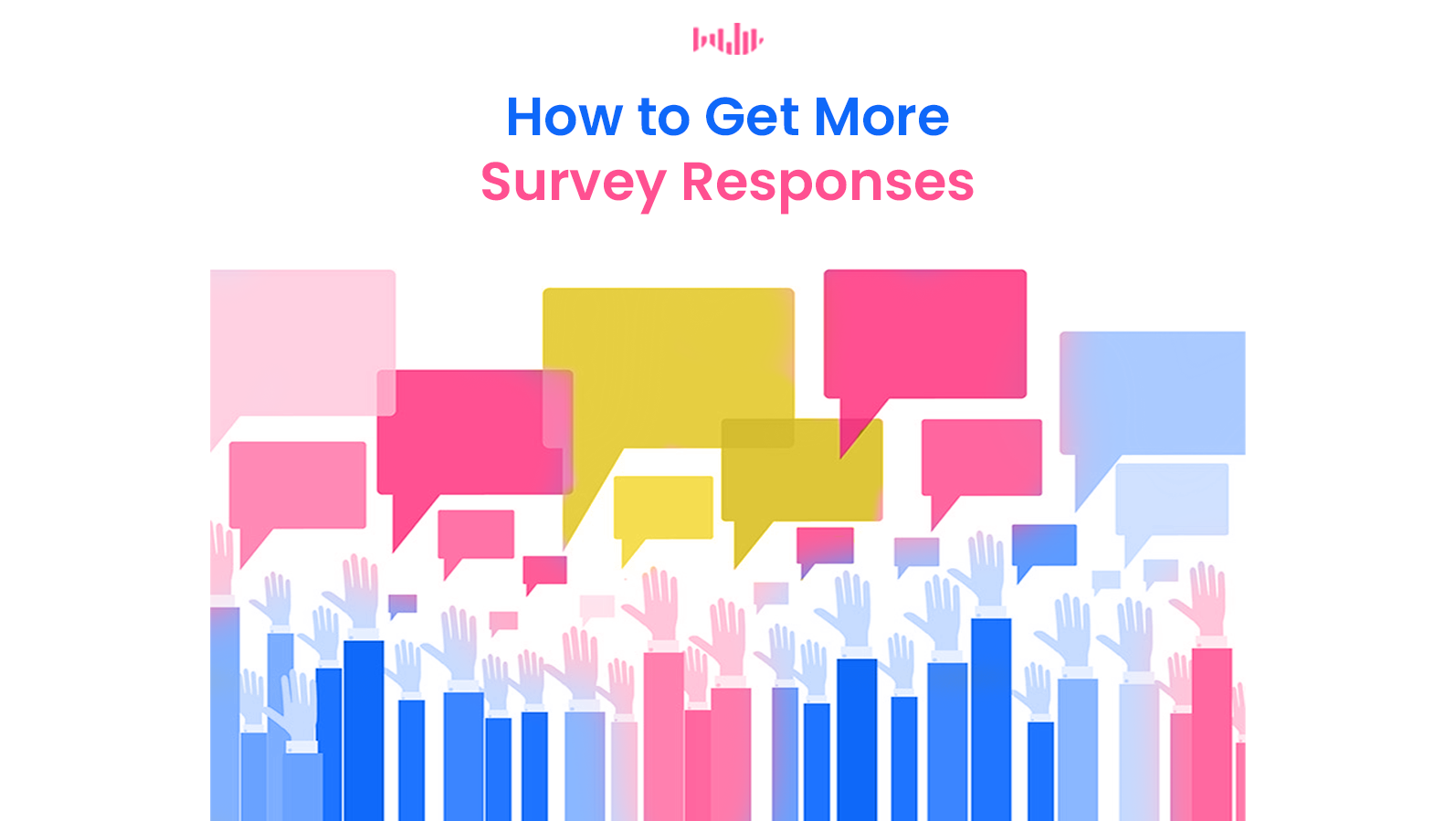
Every market researcher, marketer and business owner seeks to get more survey responses. Some studies claim that the average response rate for surveys is around 30%.
The number sounds intimidating because that means only every third person will participate in a survey.
Fortunately, there’s a lot of room for improvement. With a carefully planned and executed survey you can double and even triple the number of responses you get.
Our eight tips will help you get as many survey responses as possible without affecting the quality of your results.
#1. Keep Your Survey Simple
Whether you’re surveying your target market on complex or more general subjects, always strive to keep your survey as simple as possible. Every confusing or wordy question challenges participants’ will to focus and continue. The following includes advice on how to keep your surveys simple and engaging:
- Keep it short. Research shows that response rates are lower for longer questionnaires, so keep the number of questions in your survey in check.
- Don’t use too many open-ended questions. Asking open-ended survey questions requires more time and energy, so limit their number to maximize response rates.
- Eliminate jargon and complicated terminology. Abbreviations and jargon cause extra confusion, especially when you’re dealing with a general audience.
#2. Improve Your Targeting
It’s far more interesting and engaging to answer questions that speak directly to you rather than generic questions that could be answered by anyone else.
That’s why enhanced targeting works so well for boosting survey response rates. Suppose you’re asking a group of people about their opinion on the latest baby food product — you’ll get far better response rates when targeting parents rather than more generic sample groups.
#3. Make It Easy To Participate in Your Survey
The way you distribute your survey plays a major role in the number of respondents that will take part in your survey.
Compare these two scenarios:
Scenario #1. To participate in your survey, a participant has to open an email message, click the link, open a new website, sign up, confirm their email and then be routed to the survey.
Scenario #2. A survey starts directly in a mobile app that the person is using at the moment.
The problem with the first scenario is similar to the traditional marketing funnel conversion problem: every additional step lessens the possibility that the participant attempts the desired action.
The second scenario is rather straightforward and minimizes the number of people who opt out of the survey before it starts. Thus, to make it easy to access your survey, make sure to eliminate as many barriers to it as possible.
#4. Add Interactive And Visual Elements

Adding visual elements to your questions serves two distinct purposes.
For starters, visual content makes your survey questions easier to comprehend as 65% of humans are visual learners.
Secondly, images make your surveys more engaging — research shows that colored visuals increase people’s desire to read content by up to 80%.
Make sure you accompany your question with visual and interactive elements such as:
- sliders
- graphs.
- GIFs
- Short videos
Despite the engagement levels visuals present, don't overpack your questions with them.; Only use imagery that is relevant to your questions. There is no need for extra stimuli in leu of decorations, especially when you have several questions that feature visual elements.
#5. Keep The Flow Going
Research shows that it is becoming harder to capture respondents’ attention; over the last two decades, the average attention span decreased from 12 to 8 seconds. With so many distractions around, it’s easier than ever for respondents to drop your survey in the middle of the process and switch to their social media or web browsing.
To help you keep the engagement high, treat your survey as a narrative: create a flow where every question leads to the next one or builds around it.
For example, if you’re surveying people about phone gadgets you might start with broader questions about what phones do they use and then gradually introduce more specific questions about their apps or user preferences.
Another effective way to keep the audience engaged is to start with the most engaging and easy questions to encourage completion.
If your survey contains sensitive or private questions, save them for the middle or the end, otherwise, you risk setting the wrong tone for the whole survey. The same goes for demographic questions — you risk tiring participants by putting too many demographic questions at the beginning.
#6. Personalize Interviews
Personalization is another great way to boost the number of survey responses — studies show that personalization may increase the survey response rate by at least 8.6%.
There are several ways you can create a personalized survey experience. If you’re surveying people over email, email software allows you to automatically insert people’s names into the subject or body of your message.
And if you target a specific audience, you might greet your participants with a custom message such a “Hello young parents” or something of that nature.
Try finding ways to personalize your surveys without making the experience artificial or affecting people’s responses.
#7. Provide Incentives
Incentives can get you more survey responses, and research shows that incentives may increase response rates without affecting the quality of answers.
But there’s a catch: the correlation between is not that direct. In one study there was no noticeable difference in response rates between two surveys that promised $10 and $20 rewards respectively.
So if you want to get more responses, consider adding incentives, but track your expenses and first apply the advice from other sections in this article.
#8. Go Mobile

US adults spend almost 3 hours on their smartphones every day, and we’re only talking about active use.
In reality, our phones are always somewhere near. Which makes mobile surveys one of the most effective and fast ways of reaching out to your target audience.
Make sure that your participants can fill the survey on their mobile phones and you’ll enjoy a surge in response rates.
How To Get a 100% Response Rate
There’s a surprisingly easy way to achieve a 100% response rate for your surveys: pay only for completed responses.
Using Pollfish you can design survey questions, specify the target audience, and then get as many responses as you need.
We partnered with thousands of providers to ensure that your responses come directly from your true audience.
Check out how our next-generation survey platform helps you get survey insights you can count on.
Frequently asked questions
What is a survey response rate?
Also known as survey completion or return rate, survey response rate refers to the percentage of people who complete a survey. The response rate is calculated by dividing the number of people who returned the survey by the total number of people who received the survey.
Are short surveys better than long surveys?
Short surveys are not necessarily better than long surveys, but they are more likely to generate a higher response rate. Depending on your motivations for using a survey, you may benefit from using a short survey.
How does enhanced targeting improve survey response rate?
Enhanced targeting is used to ensure that your survey is distributed to an appropriate audience. With enhanced targeting, survey response rate is improved because the questions are relevant and interesting for the respondents, which encourages them to complete the survey.
How do visual elements improve a survey?
Visual elements can make it easier for respondents to understand the survey questions and make the survey itself more engaging.
Why is it important to ensure that online surveys are accessible on mobile devices?
The response rate of a survey is typically higher when the survey is well-formatted for a mobile device. This allows users to access and complete the survey when and where they have time, rather than waiting until they are in front of a computer.
Demographic Survey Questions to Reel in Your Target Market
Demographic Survey Questions to Reel in Your Target Market
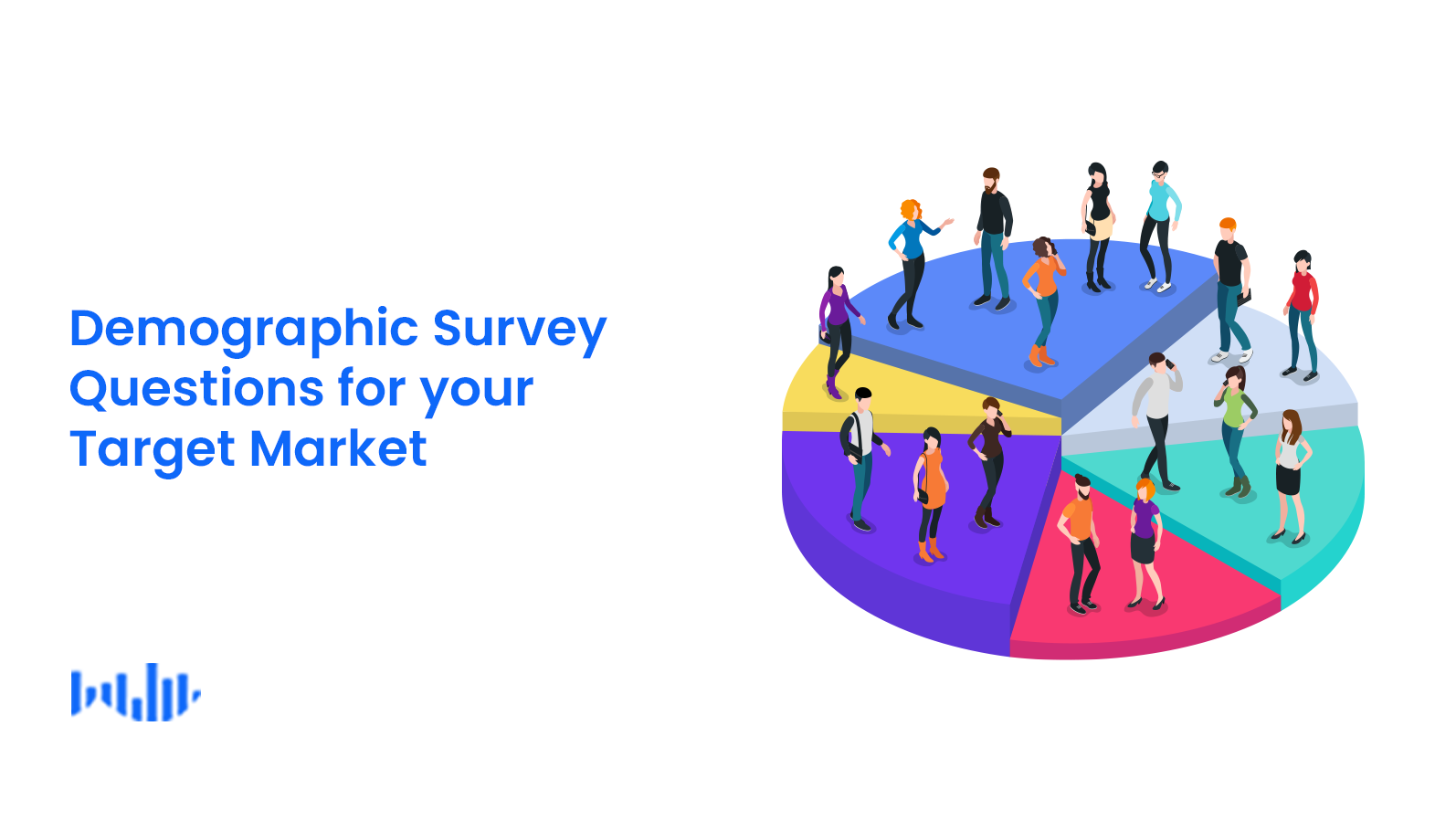 Demographic survey questions are the backbone of much of today’s survey research, as customer data has become increasingly important to businesses.
Demographic survey questions are the backbone of much of today’s survey research, as customer data has become increasingly important to businesses.
Although questions about age, marital status, education, or gender may seem simple on the surface, the data they provide is invaluable for segmenting your audience, targeting specific groups, and gaining profound survey insights.
But demographic survey questions are tricky; if you ask too many in your survey, you’ll annoy your participants. If you use a poor word choice, you risk making your audience suspicious or even offended.
In this article, we gathered the most common and useful demographic questions, examples of how you can use them in your surveys, and tips on making the most out of each.
Demographic Question #1: Age
How AGE information can be used:
- Create and polish generational-based personas. Age is often the defining factor in how people interact with your products, make decisions, or view things. No wonder there are so many age-based customer personas such as “40 y.o. office worker” or “17 y.o. college student.”
- Obtain age-unrelated insights. We often use age to segment different groups because we often perceive generations as different. But obtaining information about age also allows you to see when age doesn’t have any impact at all, making discoveries about how similar different age groups can think about the same things.
- Combine with other age-related available data. There’s a vast body of research online that focuses on behaviors and insights about different age groups. “Millennials more often…”, or “Generation X opposes…” You can combine this data with age-related insights from your surveys to obtain even more deep insights.
Tips on asking about the AGE:
- Use ranges. Age is sensitive information, so you’ll have a much higher response rate if you ask people to choose a range (e.g. 18-23) instead of providing a specific number.
- Use broad ranges or narrow ranges. If you survey the general audience, make sure you provide age ranges to cover all groups. (e.g. below 18, 18-23, 24-33, … above 65) If, however, you know that you’ll be surveying a group of young people and need more detailed age information, you can add more narrow ranges (17-18, 19-20, 21-23, other).
Example of AGE demographic question:
What is your age?
Below 18
18 – 24
25 – 34
35 – 44
45 – 54
Above 54
Demographic Question #2: Gender
How GENDER information can be used:
- Form gender-driven insights. Beware of jumping to conclusions when it comes to gender-specific insights. Often, survey data might surprise you.
- Expand to other audience groups. If you know that the target audience of your product is of a specific gender, you might target other gender groups to expand to other markets (e.g. popular men-driven gaming publication is looking for ways to expand its female audience)
Tips on asking about the GENDER:
- Don’t go all-in. Healthline currently lists 64 terms for gender identity, and if you ask participants to choose one out of 64, your survey will probably end sooner than you expect. List 5-6 most common options and cover the rest with “other.”
- Provide the way out. Gender is a sensitive topic, and some people might not want to share their details on it with you. Make sure to add the “Prefer not to answer” option to keep them in.
- Gender is not sex. Sex refers to biological distinction. Gender refers to the social or identity distinction. Don’t use “sex” and “gender” interchangeably in your questions.
Example of a GENDER demographic question:
What is your gender?
Male
Female
Trans-gender
Non-binary
Prefer not to answer
Other (please specify)
Demographic Question #3: Ethnicity
How Ethnicity information can be used:
- Diving into the cultural background of a specific group. Ethnicity may play a big role in people’s lives and affect their opinions by way of the traditions and customs they follow. As such, their views may occur through the lens of the culture that’s tied to their ethnicity.
- Enrich location-based surveys. There might be locations where a certain ethnic group holds the majority. Collecting information about ethnicity helps you discover hidden correlations or their absence by comparing survey data with data from larger audience samples.
- Target message to a specific ethnic group. If you have a business and want to join a message that resonates with certain ethnic groups, ethnic-driven surveys might be a great way to obtain actionable insights.
Tips on asking about the ETHNICITY:
- Make sure people can check off multiple answers. In the age of 23andme, more and more people consider themselves belonging to several ethnic groups, so provide your respondents with the ability to select several answers or you risk turning them away.
- Remember that ethnicity and race are different. Although closely connected, race and ethnicity are different. “Race” defines the largest categorization of people, while ethnicity is a subgroup, tied to a nationality. For example, “White” is a race, whereas “Irish” is an ethnic group falling under that race.
- Eliminate the words “ethnicity” and “race” if possible. Race and ethnicity are sensitive topics and often serve as a basis for discrimination. Try using the word “category” and let people choose the answer from groups as the following example shows.
Example of ETHNICITY demographic question:
What category describes you best?
White (e.g. Polish, German, English, Russian, etc.)
Hispanic Latino or Spanish origin (e.g. Mexican, Puerto Rican, Mexican American, Cuban, etc.)
Black or African American (e.g. African American, Haitian, Somalian, etc.)
Asian (e.g. Chinese, Japanese, Vietnamese)
American Indian (e.g. e.g Navajo, Mayan, Aztec, Nome Eskimo community, etc.)
Native Hawaiian or Other Pacific Islander
Middle Eastern or North African (e.g. Syrian, Egyptian, Lebanese, etc.)
Some other race, ethnicity, or origin
Demographic Question #4: Marital Status
How MARITAL STATUS information can be used:
More often than not, the information about marital status may not appear to be necessary, as other demographic questions will provide much clearer insight into your target audience’s choices and behaviors.
But there are cases where it can be an important differentiator, e.g. when you want to target very specific demographic groups, such as recently divorced people, etc.
Tips on asking about MARITAL STATUS:
- Beware of misinterpretations. It’s easy to jump to conclusions based on people’s marital status, especially with so many stereotypes and anecdotes floating around. In this case, it’s better to trust your data and numbers than the gut.
- Consider if you need this information. As with almost any demographic question, better ask yourself how you are going to use his data before adding the question.
- How to appeal to this demographic: To make the most use out of this demographic, consider the products, services and shopping behaviors of married respondents. These may be more willing to spend on vacations or activities designed for two.
Example of MARITAL STATUS question:
What is your marital status?
Single
Married or in a domestic partnership
Divorced
Widowed
Other
Demographic Question #5: Income or Employment
How Income or Employment information can be used:
- Obtain the economic profile of your audience. Income and employment are both strong differentiators for almost every survey as financials play a great role in how people choose what they buy and what they do.
- The differentiator in finance-specific surveys. If you are conducting a survey about finances, e.g. asking people about how they manage their personal spending habits, both income and employment will have a great impact on the results of your survey.
Tips on asking about EMPLOYMENT and INCOME:
- The money is in the follow-up. Research shows that if you ask participants to provide a specific income number with the “Don’t know” option, and then follow up with a question with income ranges (e.g. $10,000 – $20000), you’ll get more responses and than merely asking income range off the bat.
- Estimate based on other data. Not all people like to share their income details, but you might obtain income-related data indirectly. For example, if you already asked about respondents’ location and employment, you might check average salaries for that area and come up with an approximation.
Example of Employment survey question:
Full-time employment
Self-employed
Part-time employment
Underemployed (wage is below industry average)
Full time freelancing
Unemployed (looking for work)
Unemployed (not looking for work)
Student
Unable to work
Example of Income survey question:
How much total combined money did your household earn in 2020?
Less than $20,000
$21,000 – $30,000
$31,000 to $40,000
$41,000 to $50,000
$51,000 to $60,000
Above $60,000
Making The Most Out of Demographic Questions
Demographic questions help directly identify your target audience along with obtaining unique insights about a specific group of people.
Just make sure you only use those demographic questions that you really need for your research. For example, if you know that your audience is predominantly students, there’s rarely a need to ask for age, education, and type of employment.
With online survey platforms, demographic criteria can be specified before the survey starts.
If you want to take your surveys to the next step and collect even more actionable data, why not target groups that you want to survey from the very beginning?
With Pollfish you can target the right survey audience in 160 countries with over 20 various criteria such as age, gender, marital status, income, education, and even mobile device manufacturer.
Try Pollfish now and finally get advanced market insights that you can rely on.
Frequently asked questions
What is a demographic survey question?
Demographic survey questions are used to better understand the identities of the survey respondents. This information can be used to segment the survey audience in order to see how responses change based on demographic criteria.
What information is gathered through demographic survey questions?
Demographic survey questions are used to gather specific, objective information about the respondent, such as age, education, marital status, gender, household income, and employment status.
How can information about age be used when interpreting survey results?
Demographic information about survey respondents’ ages is used to create personas, understand how age impacts actions and beliefs, and identify factors that are universal amongst the respondents and not linked to age.
Why should researchers use ranges as a response to age questions?
Since some people are sensitive about age, respondents may feel more comfortable about selecting an age range rather than stating their exact age.
How many demographic questions should be included in a survey?
To ensure an optimal response rate, it is best to ask only the demographic questions you need to support your survey. When asked too many questions, respondents may get annoyed or bored and decide not to complete the survey.
5 Types of Survey Respondents to Keep an Eye On
5 Types of Survey Respondents to Keep an Eye On

When conducting a survey, it is essential to understand that, no matter how sophisticated the platform you use is, not all survey responders are keen on taking it the way you’d like.
That is to say that there will be some respondents who speed through a survey to be done with it as soon as they can, while others will take it more diligently.
These different kinds of survey respondents are not necessarily bound by a demographic; rather their style and behavior when taking surveys gives rise to their labels. Oftentimes, this is something that you can’t narrow down on a survey’s screener. You can, however, question responders on their survey-taking behaviors.
There are five types of survey respondents worth noting in your market research endeavors. They are personas — survey respondent personas to be exact — in their own right. Learn about the five respondent personas so that you can understand how your survey will be received.
The Survey Aficionados
To start this roster on a positive note, we begin by introducing the survey aficionado. Usually categorized as one of the good kinds of survey takers, survey aficionados make it their business to take surveys — they treat it as their job, or at least a source of supplemental income.
They manifest their devotion to survey-taking by taking them frequently and consuming them across websites and mobile apps. This is usually a positive behavior for marketers and market researchers, as aficionados provide sought-after participation.
However, survey aficionados can also hurt surveys, in that constant participation can yield biased results. This is especially true if they take part in surveys that deal with similar subjects.
How to attract and avoid this persona:
To attract survey aficionado respondents, offer an incentive in exchange for taking your survey. This is usually the draw of taking so many surveys for this persona, as there’s something in it for their gain.
To avoid survey aficionado respondents, screen them by asking if they’ve taken part in a recent survey on a related topic.
If you can’t do this in the screening stage of your survey, choose a platform that allows you to apply skip logic in your questionnaire.
This mechanism allows you to move a respondent to your question of choice based on their answer to a question. This way, you will avoid asking them certain questions or end the survey right then and there if they’re a bad fit.
The Flatliners
Also called straightliners, these responders engage in negative behavior when taking a survey. Flatliners tend to regularly respond as either extreme on a Likert scale survey (a survey that measures the magnitude of attitudes, opinions, or beliefs on a scale of answers, such as “highly likely” to “highly unlikely”).
As such, it is in their nature to habitually respond either on the positive end of the scale (with “strongly agree”) or on the negative side (with “strongly disagree”). Or they may respond with another answer type — continuously.
The motivation for behaving in such a way is often to complete a survey as soon as possible, making this persona a predominant kind of speeder.
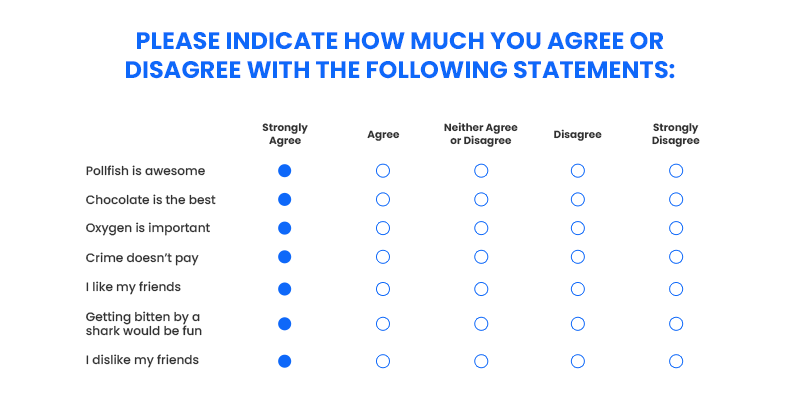
Another underlying motivation for flatliners is an innate bias, such as acquiescence bias or dissent bias.
How to avoid flatliners:
Lay off of grid or matrix questions, as they are the most likely to knuckle under the behaviors of this persona.
Use one question per page (or find a platform that does this).
If you use a platform that applies multiple questions per page, make sure they are similar.
Implement more open-ended questions that deal with the matter. Additionally, use skip logic to lead respondents to answer why they chose a particular answer to a Likert Scale question.
The Fakers
These respondents’ behavior is self-evidently negative. This persona deals with responders who do not provide genuine answers, only fake ones, hence the name. The motivation is usually to reap the reward for taking a survey.
The Fakers operate in three ways:
They create multiple accounts on a website to repeatedly take the same survey.
They use one account to take the same survey multiple times.
The most technically savvy and malicious fakers create bots to take surveys without doing the work of a survey.
Weeding out fakers has become increasingly easier, as both survey panels and platforms rely on advanced restriction functionalities.
How to avoid the fakers:
Use a platform with built-in anti-bot technology.
Use a platform that bars responders with the same IP address from taking the same survey more than once.
Ask more open-ended questions. These will easily spot fakers, as they require longer, more thought-out answers, which are much more laborious than selecting an option.
The Rule-Breakers
Much like the cheaters, and as their name implies, rule-breakers don’t adhere to the directions of a survey. While some are just looking to cause trouble and some want to finish the survey quickly, other responders may be breaking the rules unintentionally.
This is usually the result of not fully understanding a question or completely misconstruing it. Rule-breakers are a nuisance, but like the other personas, they too can be avoided.
How to avoid the rule-breakers:
Use several screening questions to prohibit the wrong kinds of respondents.
Discard respondents who manifest their lack of attention in open-ended questions.
Use skip logic to avoid possible rule-breakers, by moving responders to relevant questions only.
The Posers

Not to be confused with the fakers, posers also provide false feedback, but not because they are bots or manage multiple accounts to take the same survey more than once.
Rather, they provide dishonest responses because of a social desirability bias, a kind of inclination to answer questions in a way they believe will be viewed more favorably. This means their feedback can over-report “good responses” while downplaying the “bad responses.”
Posers do not necessarily act as their moniker in every situation, instead, they may only behave as such when answering questions on certain topics. Due to this, posters can be hard to pinpoint, but they can still be avoided.
How to avoid the posers:
When dealing with particularly sensitive topics, assuage your respondents by telling them that they are not being judged (especially in the beginning).
Assure your responders that their answers are anonymous.
Remind your responders of the importance of the accuracy of their answers.
Handling Survey Respondent Personas
With surveys becoming ever so dominant in market research, there have been evaluations on how respondents behave during their participation. Thus, the birth of five unique survey respondent personas was born.
You may discover other names for similar behaviors when reading up about these personas. Regardless of what they are called, they each present unique challenges to your market research study.
These personas may not all relate to your pool of respondents; that is why it is important to assess your surveys and look for behavioral patterns.
This is not as tedious as it appears, as some behaviors may be more obvious than others. It’s also important to rise to the challenge of understanding your customer base. You can do so by conducting the right surveys. If you can’t spot any of these personas, it is still worth sticking to the aforementioned best practices as they can prevent the “bad” types of respondents from influencing your study.
Frequently asked questions
What is a survey?
A survey is a research method that is used to gather information from a group of people in order to gain insights about a particular topic.
What are survey respondents?
In survey research, the term “survey respondents” refers to the people who take part in a survey. They make up the sampling pool.
Why is it important to be aware of certain survey personas?
In order to gain accurate and valuable insights from a survey, a company depends upon survey respondents providing truthful, unbiased information. When a large number of poor-quality responses are received, it can affect the accuracy of survey results.
What are survey aficionados?
Also known as professional survey respondents, survey aficionados are individuals who take surveys in order to make money. They are motivated to complete surveys quickly so they can respond to a large volume of surveys.
How can a company improve the quality of survey responses?
A company can increase the likelihood of gathering genuine responses by using strong screening questions and creating a well-designed survey with a good mix of survey questions.
Growing Your Business with Survey Data Analysis
Growing Your Business with Survey Data Analysis
 Don’t let the term “survey data analysis” intimidate you – organizing and analyzing survey data so you can make actionable decisions to grow your business is easier than it sounds.
Don’t let the term “survey data analysis” intimidate you – organizing and analyzing survey data so you can make actionable decisions to grow your business is easier than it sounds.
You already know that a well-executed survey can help identify areas for improvement in your business, but you may feel intimidated about the daunting task of analyzing your survey data.
After all, pages and pages of data will not help you upgrade your business unless you know how to meaningfully analyze the data and draw conclusions.
The good news is that you do not need a degree in data science to analyze your survey data like a pro!
This article explains how to execute survey data analysis, proving that the data you reap helps you draw conclusions about your target market and your industry. We broke down the process into four steps to make it easy to analyze survey data.
Step 1: Review your top questions and consider the responses
Start at the beginning by reviewing the goals you set for your market research survey. (If you are still in the planning phase, it will pay off later to carefully design your survey and set goals). Take the time to list out the top questions you want to answer during survey data analysis. This will keep you focused as you begin sifting through the data.
You also need to consider the types of responses your survey generated. Did you ask close-ended questions (yes/no or multiple-choice answers) or open-ended questions (fields with text entry allowing for a more elaborate response).
Close-ended questions let you generate empirical data that can be useful for drawing conclusions. Open-ended questions require careful review, but can reveal richer insights than empirical data can alone.
Let’s consider a sample scenario where a business owner wants to know how they can improve their ecommerce business. A top research question in this example might be: “Are customers happy with the checkout experience?”
It is easy to find the answer to this question since it was asked directly during the survey:
| Were you satisfied with the checkout experience? | % | Number |
| Yes | 74% | 148 |
| No | 26% | 52 |
In this scenario, the majority of users are happy with the checkout experience. But what about the 5 respondents who are not happy? How can we use data to understand how to improve the checkout experience? For that, we need to dig deeper.
Step 2: Review, filter, and cross-tabulate your data
If you are using a survey platform like Pollfish, you will have access to a powerful dashboard that allows you to view and filter your survey data. From the dashboard, you can filter and segment your survey results in real-time. For an advanced analysis, you should study it in a variety of formats, such as graphs, charts, and spreadsheets. You can use the latter to create crosstabs.
What are crosstabs?
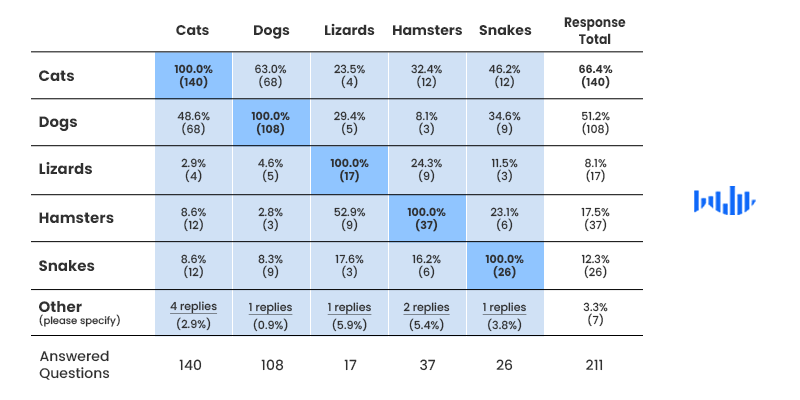
Crosstab (short for cross-tabulation) is a special type of report that is used to explore the relationship between variables. It is essential in survey data analysis because it lets us segment survey data and examine responses for different segments. For example, we can examine satisfaction levels of the online shopping experience based on the subjects’ age, education level, payment type, etc. Pollfish provides crosstab functionality within the results dashboard, which streamlines the process for you.
Going back to our sample scenario, let’s see how we could determine which payment method is giving users the most problems. To do this, we need to crosstab the results to view payment types and satisfaction levels.
We are looking at two sets of data:
- The type of payment method used by respondents
- Whether they were satisfied during the checkout process
| Payment Type | Satisfied (yes) | Unsatisfied (no) |
| Visa/Mastercard | 86% (128) | 6% (3) |
| Apple Pay | 11% (17) | 6% (3) |
| PayPal | 2% (3) | 88% (46) |
The crosstab report reveals that customers who used PayPal overwhelmingly expressed dissatisfaction with the checkout process, providing insight that something in the PayPal process is falling short.
In the same way, you can apply crosstabs to examine the satisfaction levels voiced by other segments. Are people who shopped on their mobile devices happy with the checkout? What about an older segment of users compared to a younger one?
Step 3: Understand the statistical significance

Before drawing conclusions about your data and investing in changes to your business or website, you must crunch the data to understand if the results can be trusted. An important aspect of survey data analysis is assessing the statistical significance of your results. In the realm of data analysis, statistical significance is what helps us determine how accurate our data is.
To do this, you need to consider these factors:
- Sample size refers to the number of respondents in your survey. The larger your sample size, the more confident you can be about the results.
- Effect size describes the amount of difference between the data you are comparing. If you have a small effect size, you would need a larger sample size to understand if the difference is statistically significant (and worth acting on) or a result of chance.
In our online shopping example, the dissatisfaction voiced by PayPal users is significant and should be explored further. The percent of dissatisfied customers who used a credit card or PayPal is low enough that exploring this is unlikely to yield meaningful results, unless you can determine a third factor in this subset (for example, 100% of the dissatisfaction comes from mobile users).
Step 4: Draw conclusions and create a plan for improvement
Now for the fun part! After you have organized, reviewed, and understood your data, it is time to draw conclusions and determine how this information can be used to improve your business.
Go back to your original research questions. Sift through the data until you are able to answer each of these questions and draw conclusions.
In some cases, a course of action will be very obvious. In our sample scenario, it is clear that this business owner needs to uncover issues in the PayPal checkout experience.
It may be harder to understand why other segments feel unhappy with their shopping experience.
For example, you may understand that those aged 65+ stated dissatisfaction but cannot find a clear relationship that explains why. In these cases, your open-ended questions may reveal insights that may help you interpret the dissatisfaction voiced by this segment.
With your theories and conclusions in hand, create a plan for systematically improving each area of concern. In our example scenario, some changes to how the users move from the store to PayPal may improve the experience and overall satisfaction levels. Once you have made changes, you can understand their impact by running another survey and using your new data analysis skills to understand the change.
Pollfish makes it even easier
At Pollfish, we provide our clients with a dashboard that makes survey data analysis easier – you can review your responses in real-time and access visual data directly in the dashboard. You can view your data in classic mode or in a number of visual sources (thinks charts and graphs). You can also export your data for official reporting and set up cross-tabs. Ready to launch your survey?
Frequently asked questions
What is survey data analysis?
Survey data analysis is the process of organizing and reviewing survey data in order to draw conclusions and gain insights.
What are crosstabs?
Crosstabs, also known as cross-tabulations, are data tables that are organized in a way that allows a researcher to identify relationships between variables in survey data.
What is statistical significance?
Statistical significance is used in data analysis to understand how likely it is that survey results are accurate and not the result of random chance.
What is a sample size?
A sample size defines the total number of individuals who are chosen to participate in a survey or experiment.
What is the effect size?
The effect size is a numerical measure of the difference between two variables. The larger the effect size, the more confident a researcher can feel about the results of a survey or experiment.
How to Conduct Real Estate Market Research Like a Pro
How to Conduct Real Estate Market Research Like a Pro

Conducting real estate market research is a considerably different feat than conducting any other kind of market research. This is because this vertical, by its very nature, is packed with market intelligence that can be applied not simply to real estate companies, but to buyers and agents, along with those looking for a new property.
Therefore, as a business, you’ll find a lot of overlap between business-facing research and research that the target market can stand to study. However, even when you come across information that seems more suitable for consumers to review, it is of high value to your business as well.
Why? Because it is crucial to tap into the minds of your target market, to see exactly what they’re presented with. This intel will also grant you comparisons between your own offerings and those in the real estate market.
The Main Uses of Real Estate Market Research
Research for the real estate vertical can be used for a variety of purposes. The chief goal of market research for this industry is to discover if your business will be successful in a particular location.
Unlike other industries, real estate has an enormous focus on location and the brick and mortar aspect. It is self-explanatory as to why that is, nonetheless, getting a deep understanding of your target market is also essential.
Here are the key uses of market research for this sector:
- To understand changes and trends in the real estate market at large
- To understand the current housing/ space rental markets
- To compare prices of similar properties with yours
- To be informed on how much you can charge for rent (particularly for investment properties)
- To gauge your own prices as reasonable, too high or too low
- To be able to market your properties successfully (gain better reach, prospects and sales)
- To choose the proper investments
How to Conduct Real Estate Market Research
The following lists the necessary steps towards conducting a sufficient market research campaign within the real estate market. You’ll notice that this vertical demands doing an analysis on various elements. These remain constantly in existence in the sector, so it is critical to understand how to study each.
You’ll also notice that observing your target market doesn’t occur at a single step, rather it should be done in a variety of stages.
Step 1: Narrow down a region/neighborhood
Since real-estate is location-based, you must first settle on a region or a neighborhood you are interested in serving. If you are undecided, consider a few areas that you’d like to learn more about.
Identify the target market of your neighborhood. You can do so via secondary research, by finding the demographics of your intended neighborhood. There are several sources that fetch this data, including Neighborhood Scout, Census demographics data, for example for New York City and Movoto.
Aside from gleaning the target market, these tools gather other key info like crime, local schools and even real estate data.
Step 2: Study Your Competition
Once you have narrowed down a few neighborhoods to research, along with their respective target markets, it’s time to focus on the competition.
That means looking further into secondary sources. To do so, check for websites that provide real estate agent, vendor, supplier information in specific localities. BiggerPockets and Parkbench neighborhood marketing platform, for example, provide information on local real estate agents and vendors.
As for a neighborhood itself, look into The Federal Housing Finance Agency (FHFA). This website provides data on recently sold properties in specified areas.
You can also check The FNC Residential Price Index. This platform features exhaustive and up-to-date data on the real estate market from public records and valuations. This index also shines a light on market trends.
Step 3: Observe Your Desired Neighborhoods
Aside from looking at your direct competitors in the particular neighborhoods you set your sights on, you should also look into each neighborhood’s supply. This refers to the number of properties currently on offer in the neighborhoods.
Then, you’ll need to find how in-demand a particular neighborhood is. To find this, you’ll have to survey your target market, or even the broader market of consumers seeking to find a residence or space to move into.
If you survey your target market, you can get their opinions about moving into a neighborhood. The more responders who prefer a neighborhood, the more expensive its properties become. In short, demand dictates the competition of a region.
As part of your neighborhood observation, peruse several listings of the available properties, office space, apartments, or whichever real estate is most relevant to you. Pay attention to the prices in particular and compare them with your existing ones, or the ones you set out to charge.
This will give you a real-world view of pricing and pricing expectations of your target market.
Step 4: Analyze the physical elements of a neighborhood/property
Analyzing the properties of a neighborhood and the real estate you seek to sell requires not merely examining the physical properties of a home. Rather it also involves inspecting public utilities and services, along with general environmental aspects.
Here are the most pressing aspects to inspect that affect a property’s standing:
- Water resources
- Soil
- Transportation in the area
- Regional climate
- Utilities offered and their functionality
Afterward, you will need to inspect the property itself.
- Size and square footage
- Number of rooms (bedrooms, bathrooms, other rooms)
- Age of properties (newer buildings tend to have a higher value)
- Amenities (decks, fireplaces, gardens, balconies, etc.)
- ANy recent or noteworthy improvements/ restorations
Step 5: Gauge how the neighborhood has been faring
After you examine the physical characteristics, you should get a deep read of how the neighborhood has been faring. This includes delving into the economics, construction and business performance of the region.
When developments are underway, they could impact a neighborhood’s properties. At times, they may incite new companies to arrive in the region. Some may impact the local economy positively, while others may worsen it.
An uptick in commercial real estate is usually a sign of a healthy local economy. This will stoke the interest of buyers and with more sales, the cost per property square foot will be on the rise.
Research the demographics of the neighborhood. This will allow you to be clued in to the target market as well as giving your buyers more insights. An elderly population, for example, is great to highlight to retirees and others within this age range.

But perhaps younger buyers are seeking a neighborhood with other young professionals.
Moreover, age and ethnicity are not enough to determine how a neighborhood will fare — and neither how your business will either. You’ll need to understand your target market at a deeper level.
That is where surveys rear their usefulness again. A survey with the right questions will give you all the answers you need to understand how to best appeal to your target market. It can also give you more insight as to the price and style of real estate your consumers are seeking.
A Wavering Market
The real estate market is notorious for its rising costs, whether they concern rent or ownership. Unfortunately, this market has also been under the mercy of rocky times, such as the Great Recession and the Covid-19 pandemic. They have negatively affected sales and demand, especially for urban areas such as New York City.
Due to an exodus from Covid-19 hot spots, which were mostly urban, (at least early in the pandemic) suburban real estate has soared.
Despite the wavering market, any real estate business has much to gain from conducting real estate market research. There are several secondary sources available (though not all are free). For primary research, surveys help carry out the bulk of understanding your target market. They will provide your firm with answers directly from consumers themselves, on all your most sought-after questions.
Frequently asked questions
What is market research?
Market research is the process of gathering information about target customers and markets in order to improve or introduce a product, feature, or service.
What is the goal of real estate market research?
The main goal of real estate market research is to understand if a real estate business will succeed in a specific location.
What factors should be considered while conducting real estate market research?
During a real estate market research project, you should seek to understand the following: changes in the market as a whole, current demand for and pricing of housing or commercial space, how your own prices compare to market averages, and current real estate marketing trends.
How can surveys be used during real estate marketing research?
A survey can provide real-time insight into market demands such as pricing, style, and how to appeal to your target audience.
How can demographics be used to plan marketing efforts?
By understanding the demographics of a target location, you can better understand the types of housing the population requires, their price points, and how to market to the various segments.
Marketing & Market Research: How Customer Insights Inform Digital Marketing
Marketing & Market Research: How Customer Insights Inform Digital Marketing

We live in a time of increasingly rapid market shifts, so it’s important to continuously test channels, tactics, and audiences and reflect on the strategies you employ. With marketing market research as an ongoing activity, you can understand changing consumer preferences and market dynamics, and adapt your campaigns before your competitors do.
When collected and interpreted effectively, the intelligence you gain from marketing market research will boost the effectiveness of any marketing campaign, and generate stronger engagement with your target audience.
It provides a deeper understanding of how your value proposition is perceived and helps you deliver compelling messaging to your customers on the platforms they frequent the most and in a format they will enjoy consuming.
Categories of Marketing Market Research
Broadly speaking, there are five different categories of market research that are relevant to digital marketing:
- Brand research: Gathering insights that help with developing and managing a company’s brand identity. This could take many forms, from understanding which charities your audience supports to planning corporate partnerships, todesigning imagery, using cultural references, language, and color palettes.
- Customer research: Providing insights into the demographics, attitudes, and behaviors of customers (or prospective customers) and identifying niches to take advantage of for your messaging, targeting, or campaign deployment.
- Campaign efficiency: Measuring the effects of your message’s efficiency (whether it’s getting through, and that your target market is responding to your campaign favorably).
- Competitor research: Evaluating the strengths and weaknesses of your competitors, and/or asking consumers about their own perception of other brands in your niche.
- Product development: Crowdsourcing knowledge and opinions to inform the design of a product or service. This involves digging into the experience of using something, also widely known as UX (user experience)which can uncover previously unknown customer pain points and motivations.
Marketing departments are interested in usability testing, so they can see how customers interact with product features in real time. This can reveal hidden bugs and unseen obstacles.
However, the five categories mentioned above are the ones that yield data that will inform your digital marketing strategy, because they give you insight into your audience’s values, behavior, experiences, and perspectives.
Researching Channels & Content Formats for Marketing

Successful marketing campaigns convey a compelling message in the right place, at the right time, to the right people. And to have an impact, you need a media strategy that makes sense in the channels and platforms on offer. With this in mind, your early research can focus on:
- Marketing channels: Part of understanding your audience persona is to know about which channels you can reach them on, and what state of mind they’re in while using them. If your campaign goal is immediate sales, you need to find out where your audience is in a need state – i.e. where they’re ready to buy.
For example, your audience might be socially active on Instagram, but not ready or willing to buy. This could lend itself to a brand-led awareness campaign. But for direct sales or lead generation goals, the right channel might actually be Google Search. - Content formats: Naturally, each channel requires distinct formats and structures for content. For example, if surveys indicate that your audience browses YouTube to educate themselves about DIY, this could be a perfect channel for how-to video content or direct response advertising campaigns promoting your new drill range.
While market research can’t help you analyze the success or failure of your tests on different digital channels, asking the right questions sets you up with educated hypotheses. This is superior to relying on your gut instinct alone, and means that you’ll get started on the right foot.
Survey Strategies: How to Get Insights for Your Marketing
Survey strategies have adapted with technology, and many businesses have moved away from traditional approaches towards online methods. Here are three of the most popular online survey approaches around right now:
- Online panels: Online panels collect responses from opted-in panelists who are recruited to participate in specific surveys. With online panels, you can also track trends in responses over time from the same people. However, they have downsides, including panel fatigue, conditioning, and declining participation over time.
- Assisted crowdsourcing: This method invites respondents to participate in a survey through social media. It can have huge penetration, yielding a lot of data. But biases can be introduced by quota sampling, which can lead to serious polling errors.
- Random Device Engagement (RDE): RDE organically engages respondents (a.k.a.. organic sampling), who are randomly picked from the target audience through the devices, software, or apps that they’re already using. Participants respond to a survey in exchange for an incentive within the delivery platform. Pollfish uses this methodology.
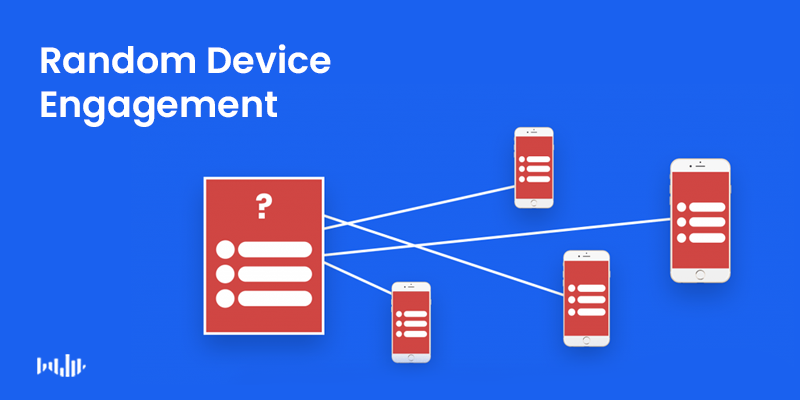
RDE is the immediate successor to Random Digit Dialling (RDD), improving massively on this method by targeting the user’s unique ID – which can be tracked across multiple devices and platforms. This also helps prevent fraud, and the quantity of paradata available when using RDE allows for considerable bias correction within the results.
By merging machine learning technology with organic sampling methodologies like RDE, at Pollfish we can increase the value of your data by extracting authentic responses from an engaged and representative audience. Combined with massive coverage and programmatic delivery across over 140,000 partner apps, this yields instantaneous and reflexive responses.
These responses are taken randomly from a target sample, who can participate in the surveys without unduly disrupting their normal engagement with their device. This means that your research is conducted in a natural atmosphere, rather than in an unfamiliar environment.
Gaining Insights Quickly for Your Digital Marketing
Market research surveys can help you set up your marketing campaigns with a better chance of targeting the right audiences with the right messages in the right channels. However, not all survey strategies are created equal, and not all will get quality data in a reasonable timeframe.
Programmatic delivery using organic sampling and RDE allows you to get hold of insights quickly, without sacrificing the data quality. This fast-moving intelligence is particularly useful for marketers who are testing different digital channels and messages to work out the best strategies for generating leads, sales, or brand awareness.
Do you want to distribute your survey? Pollfish offers you access to millions of targeted consumers to get survey responses from $0.95 per complete. Launch your survey today.
Frequently asked questions
What are the five categories of market research?
Market research can be broken into five main categories: brand research, customer research, campaign efficiency, competitor research, and product development.
What is a marketing channel?
The term marketing channel refers to the area in which a company can reach prospective customers in order to sell their product or service.
What are some examples of marketing channels?
Marketing channels include social media, online advertising, salespeople, catalogs, and in-person experiences.
How can market research help improve a marketing campaign?
Market research provides a better understanding of the target market so a company can create a message that will be compelling to those customers, thereby achieving greater ROI on that campaign. It also helps them understand the platform and format that will be most effective in reaching this audience.
What is assisted crowdsourcing?
Assisted crowdsourcing is a survey method that uses social media to source the survey respondents. It is typically able to gather responses from large numbers of people, resulting in a great amount of usable data.
How to Conduct Retail Market Research Like a Pro
How to Conduct Retail Market Research Like a Pro
 Whether you operate a brick-and-mortar, a click-and-mortar, or a pure-play brand, you need to conduct retail market research, that is, market research specific to the retail sector.
Whether you operate a brick-and-mortar, a click-and-mortar, or a pure-play brand, you need to conduct retail market research, that is, market research specific to the retail sector.
That is because, in today’s age of mass information circulating at speed, we exist in a market jungle, as market trends oscillate and customer expectations sway, while your competitors are becoming more adaptable.
To stay ahead and survive this market jungle, you need to get acclimated to performing the correct form of market research.
Let’s learn how to conduct market research for the retail sector.
The Makeup of Market Research
Market research, as we’ve covered aplenty, is a wide umbrella term that pertains to studying several facets of a particular market to gauge the profitability and success of your product or service.
This includes gathering information on the following:
- Trends in the sector, vertical and niche
- Your target market
- Segmentation within your target market
- Your competitors (tactics, launches, performance, etc.)
- The sector at large

It is made up of two sets of research: primary and secondary. The former deals with gathering research that you, as a business, conduct yourself. The latter involves consulting with information that has already been researched and is publicly available (not always for free).
Primary research requires using the following methods to collect information:
- Surveys on your target market and closely situated markets
- Interviews (in-person or over the phone)
- Consumer reviews
- Focus groups
- Sales records
- Employee feedback
Secondary research has a more encompassing set of documents and sources:
- Trends sites (Google Trends, Google Alerts)
- Keyword searching and SEO platforms
- Research agencies
- Statistics sites
- Market research sites
- Competitor sites
- Case studies
Techniques Particular to Retail Research
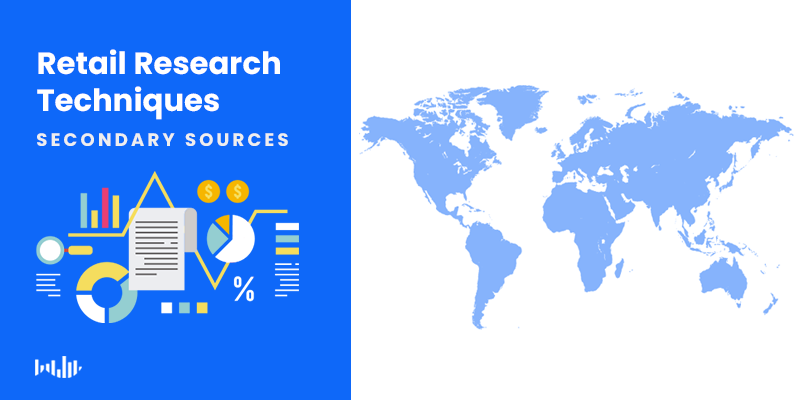
The above provides fundamental information about performing market research — in a general, all-purpose sense.
Since you would need to turn to both primary and secondary data throughout the market research process, you should be able to detect and distinguish these resource types, whenever you come upon them.
Above all, you need to know which exact platforms, websites and tools to use for collating information on the sector of retail. In market research, you move from the general to the specific fairly quickly, and you’ll need information specific to your vertical.
This is especially important if you serve a niche market.
Primary research techniques speak for themselves, as you would need to gather original insights and data from those mentioned above. Secondary sources particular to the retail sector, on the other hand, need to be laid out.
Secondary Research Sources for Retail
Here are a few secondary sources for market research on the retail vertical. Note that many of these platforms aren’t free, but their intel is indispensable.
- For understanding the retail industry: MarketResearch.com, specifically the Retailing Market Research Reports & Industry Analysis page, which links to a wide variety of internal research reports. These reports cover the many sub-sectors of the sweeping retail vertical, such as the clothing market, department stores and other related topics such as market analytics.
- For understanding customer personas: MakeMyPersona You should constantly be up to date on your buyer personas. This free tool from HubSpot generates personas; all you have to do is answer some questions about your ideal customers. The tool then creates a detailed document on your target market.
- For economic data in the retail sector: Business Dynamics Statistics (BDS) A division of the US Census Bureau, this program provides economic data on employment, job expansions/ contractions, number of establishments, number of startups and more. This platform supplies annual measures on different business subsectors.
- For competitor analysis: County Business Patterns (CBP) Another division of the US Census Bureau, this program presents subnational economic data based on various retail industries. This includes the number of establishments, employment, annual payroll and more to analyze economic changes over time.
- For understanding your customer base: Facebook Audience Insights If your business has a Facebook business page, this tool will provide demographic information, along with some behavioral insights into your followers. It shows you their age, location, income, employment type, spending behaviors and even lifestyle (Facebook’s category).
- For multipurpose research: Think with Google An all-in-one market research platform providing guides, data reports, infographics and content to reap insights on the retail industry and your target market. You can use specific tools to grow your store, find your audience and stay up to date with the latest research within your particular retail subsector.
- For keyword research, SEO and competitor analysis: SEMrush This platform offers over 30 tools to analyze 3.7 billion keywords and 4 trillion backlinks. It allows retailers to find new organic competitors, as well as those in Google AdWords and Bing ads, to analyze their competitors’ budgets, strategies, ad copy, display ads and keywords.
Wrapping Things Up
Retail is one of the most expansive verticals, as it can include virtually any business that sells products to consumers. It requires both primary and secondary research methods for a thorough analysis and interpretation.
Secondary research for the retail sector involves a distinct set of secondary sources for quality research campaigns. A successful research endeavor will allow you to provide meaningful products and experiences for your customers, communicate with them more productively and improve your standing within your submarket.
Although the above examples of secondary research are invaluable, there are many other online tools for your disposal. Social media, for example, is excellent for market research, as it can connect you with your customers to get their perspectives firsthand, along with their data.
Frequently asked questions
What is retail market research?
Retail market research is the process of gathering information about target customers and markets to determine or improve upon the success of a retail venture.
What types of primary research are useful in retail market research?
The most relevant types of primary research for the retail sector are surveys, consumer reviews, focus groups, feedback from employees, and sales reports.
How is secondary research performed?
Secondary research is performed by gathering and reviewing previously published information in order to gain insights to support a market research project.
How are buyer personas used in retail market research?
Buyer personas are a good way to define and understand the various customer segments that are likely to purchase from your retail store.
What information can Facebook Audience Insights provide about your retail business?
A shop’s Facebook business page can provide a wealth of information about its followers, including age, location, employment, income, spending behaviors, and lifestyle preferences.













